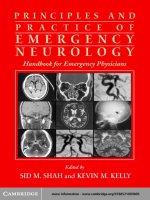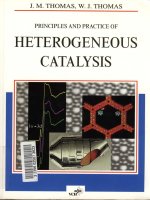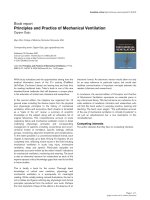Principles and practice of analytical chemistry
Bạn đang xem bản rút gọn của tài liệu. Xem và tải ngay bản đầy đủ của tài liệu tại đây (7.29 MB, 680 trang )
www.pdfgrip.com
Page iii
Principles and Practice of Analytical Chemistry
Fifth Edition
F.W. Fifield
Kingston University
and
D. Kealey
University of Surrey
www.pdfgrip.com
Page iv
© 2000 by
Blackwell Science Ltd
Editorial Offices:
Osney Mead, Oxford OX2 0EL
25 John Street, London WC1N 2BL
23 Ainslie Place, Edinburgh EH3 6AJ
350 Main Street, Malden MA 02148 5018, USA
54 University Street, Carlton Victoria 3053, Australia
10, rue Casimir Delavigne 75006 Paris, France
Other Editorial Offices:
Blackwell Wissenschafts-Verlag GmbH
Kurfürstendamm 57
10707 Berlin, Germany
Blackwell Science KK
MG Kodenmacho Building
7–10 Kodenmacho Nihombashi
Chuo-ku, Tokyo 104, Japan
The right of the Authors to be identified as the Authors of this Work has been asserted in accordance
with the Copyright, Designs and Patents Act 1988.
All rights reserved. No part of this publication may be reproduced, stored in a retrieval system, or
transmitted, in any form or by any means, electronic, mechanical, photocopying, recording or
otherwise, except as permitted by the UK Copyright, Designs and Patents Act 1988, without the prior
permission of the publisher.
First Edition published 1975 by Chapman & Hall
Second Edition 1983
Third Edition 1990
Fourth Edition 1995
This Edition published 2000
Set in 10/12pt Times by DP Photosetting, Aylesbury, Bucks Printed and bound in the United Kingdom
at the University Press, Cambridge
The Blackwell Science logo is a trade mark of Blackwell Science Ltd, registered at the United Kingdom
Trade Marks Registry
DISTRIBUTORS
Marston Book Services Ltd
PO Box 269
Abingdon
Oxon OX14 4YN
(Orders: Tel: 01235 465500
Fax: 01235 465555)
www.pdfgrip.com
USA
Blackwell Science, Inc.
Commerce Place
350 Main Street
Malden, MA 02148 5018
(Orders: Tel: 800 759 6102
781 388 8250
Fax: 781 388 8255)
Canada
Login Brothers Book Company
324 Saulteaux Crescent
Winnipeg, Manitoba R3J 3T2
(Orders: Tel: 204 837-2987
Fax: 204 837-3116)
Australia
Blackwell Science Pty Ltd
54 University Street
Carlton, Victoria 3053
(Orders: Tel: 03 9347 0300
Fax: 03 9347 5001)
A catalogue record for this title is available from the British Library
ISBN 0-632-05384-4
Library of Congress
Cataloging-in-Publication Data
Fifield, F.W. (Frederick William)
Principles and practice of analytical
chemistry/F.W. Fifield and D. Kealey.
p. cm.
Includes bibliographical references and
index.
ISBN 0-632-05384-4 (pbk).
1. Chemistry, Analytic. I. Kealey, D.
(David) II. Title.
QD75.2 .F53 2000
543 – dc21
99-059799
For further information on Blackwell Science, visit our website: www.blackwell-science.com
www.pdfgrip.com
Page v
Contents
Preface
xi
Acknowledgements
1
Introduction
xiii
1
The Scope of Analytical Chemistry. The Function of Analytical
Chemistry. Analytical Problems and Their Solution. The Nature of
Analytical Methods. Trends in Analytical Methods and Procedures.
Glossary of Terms.
2
The Assessment of Analytical Data
13
2.1 Definitions and Basic Concepts
13
2.2 The Nature and Origin of Errors
16
2.3 The Evaluation of Results and Methods
17
The Reliability of Measurements. The Analysis of Data. The
Application of Statistical Tests. Limits of Detection. Quality
Control Charts. Standardization of Analytical Methods.
Chemometrics.
Problems
34
3
pH, Complexation and Solubility Equilibria
37
3.1 Chemical Reactions in Solution
38
Equilibrium Constants. Kinetic Factors in Equilibria.
3.2 Solvents in Analytical Chemistry
41
Ionizing Solvents. Non-ionizing Solvents.
3.3 Acid–base Equilibria
Weak Acid and Weak Base Equilibria. Buffers and pH Control. The
43
www.pdfgrip.com
pH of Salt Solutions.
3.4 Complexation Equilibria
49
The Formation of Complexes in Solution. The Chelate Effect.
3.5 Solubility Equilibria
52
Solubility Products.
Problems
4
Separation Techniques
4.1 Solvent Extraction
53
54
55
Efficiency of Extraction. Selectivity of Extraction. Extraction
Systems. Extraction of Uncharged Metal Chelates. Methods of
Extraction. Applications of Solvent Extraction.
4.2 Solid Phase Extraction
Solid Phase Sorbents. Solid Phase Extraction Formats. Automated
Solid Phase Extraction. Solid Phase Microextraction. Applications
of SPE and SPME.
73
www.pdfgrip.com
Page vi
4.3 Chromatography
80
4.3.1 Gas Chromatography. 4.3.2 High Performance Liquid
Chromatography. 4.3.3 Supercritical Fluid Chromatography. 4.3.4
Thin-layer Chromatography. 4.3.5 Ion-exchange Chromatography.
4.3.6 Size Exclusion Chromatography.
4.4 Electrophoresis
170
Factors Affecting Ionic Migration. Effect of Temperature. pH and
Ionic Strength. Electro-osmosis. Supporting Medium. Detection of
Separated Components. Applications of Traditional Zone
Electrophoresis. High-performance Capillary Electrophoresis.
Capillary Electrochromatography. Applications of Capillary
Electrochromatography.
Problems
5
Titrimetry and Gravimetry
5.1 Titrimetry
188
191
191
Definitions. Titrimetric Reactions. Acid-base Titrations.
Applications of Acid–base Titrations. Redox Titrations.
Applications of Redox Titrations. Complexometric Titrations.
Ethylenediaminetetraacetic Acid (EDTA). Applications of EDTA
Titrations. Titrations with Complexing Agents Other Than EDTA.
Precipitation Titrations.
5.2 Gravimetry
216
Precipitation Reactions. Practical Gravimetric Procedures.
Applications of Gravimetry.
Problems
6
Electrochemical Techniques
6.1 Potentiometry
226
228
232
Electrode Systems. Direct Potentiometric Measurements.
Potentiometric Titrations. Null-point Potentiometry. Applications of
Potentiometry.
6.2 Polarography, Stripping Voltammetry and Amperometric
247
www.pdfgrip.com
Techniques
Diffusion Currents. Half-wave Potentials. Characteristics of the
DME. Quantitative Analysis. Modes of Operation Used in
Polarography. The Dissolved Oxygen Electrode and Biochemical
Enzyme Sensors. Amperometric Titrations. Applications of
Polarography and Amperometric Titrations.
6.3 Electrogravimetry and Coulometry
260
Coulometry. Coulometry at Constant Potential. Coulometric
Titrations. Applications of Coulometric Titrations.
6.4 Conductometric Titrations
264
Ionic Conductances.
Problems
7
An Introduction to Analytical Spectrometry
Electromagenetic Radiation. Atomic and Molecular Energy. The
Absorption and Emission of Electromagnetic Radiation. The
Complexity of Spectra and the Intensity of Spectral Lines.
Analytical Spectrometry. Instrumentation.
267
270
www.pdfgrip.com
Page vii
8
Atomic Spectrometry
8.1 Arc/Spark Atomic (Optical) Emission Spectrometry
284
289
Instrumentation. Sample Preparation. Qualitative and Quantitative
Analysis. Interferences and Errors Associated with the Excitation
Process. Applications of Arc/Spark Emission Spectrometry.
8.2 Glow Discharge Atomic Emission Spectrometry
295
Instrumentation. Applications.
8.3 Plasma Emission Spectrometry
298
Instrumentation. Sample Introduction for Plasma Sources.
Analytical Measurements. Applications of Plasma Emission
Spectrometry.
8.4 Inductively Coupled Plasma–mass Spectrometry (ICP–MS)
305
Principles. Instrumentation. Applications.
8.5 Flame Emission Spectrometry
312
Instrumentation. Flame Characteristics. Flame Processes. Emission
Spectra. Quantitative Measurements and Interferenccs. Applications
of Flame Photometry and Flame Atomic Emission Spectrometry.
8.6 Atomic Absorption Spectrometry
320
Absorption of Characteristic Radiation. Instrumentation. Sample
Vaporization. Quantitative Measurements and Interferences.
Applications of Atomic Absorption Spectrometry.
8.7 Atomic Fluorescence Spectrometry
333
8.8 X-ray Emission Spectrometry
335
X-ray Processes. Instrumentation. Applications of X-ray Emission
Spectrometry.
Problems
9
Molecular Spectrometry
352
354
www.pdfgrip.com
9.1 Visible and Ultraviolet Spectrometry
363
Polyatomic Organic Molecules. Metal Complexes. Qualitative
Analysis – The Identification of Structural Features. Quantitative
Analysis – Absorptiometry. Choice of Colorimetric and
Spectrophotometric Procedures. Fluorimetry. Applications of
UV/Visible Spectrometry and Fluorimetry.
9.2 Infrared Spectrometry
378
Diatomic Molecules. Polyatomic Molecules. Characteristic
Vibration Frequencies. Factors Affecting Group Frequencies.
Qualitative Anlaysis – The Identification of Structural Features.
Quantitative Analysis. Sampling Procedures. Near Infrared
Spectrometry. Applications of Infrared Spectrometry.
9.3 Nuclear Magnetic Resonance (NMR) Spectrometry
396
Instrumentation. The NMR Process. Chemical Shift. Spin–spin
Coupling. Carbon-13 NMR. Pulsed Fourier transform NMR (FTNMR). Qualitative Analysis – The Identification of Structural
Features. Quantitative Analysis. Applications of NMR
Spectrometry.
9.4 Mass Spectrometry
426
Instrumentation. Principle of Mass Spectrometry. Characteristics
and Interpretation of Molecular Mass Spectra. Applications of Mass
Spectrometry.
9.5 Spectrometric Identification of Organic Compounds
440
www.pdfgrip.com
Page viii
10
Radiochemical Methods in Analysis
10.1 Nuclear Structure and Nuclear Reactions
450
451
Decay Reactions. The Kinetics of Decay Reactions. Bombardment
Reactions and the Growth of Radioactivity.
10.2 Instrumentation and Measurement of Radioactivity
457
Radiation Detectors. Some Important Electronic Circuits.
Autoradiography. The Statistics of Radioactive Measurements.
10.3 Analytical Uses of Radionucleides
467
Chemical Pathway Studies. Radioisotope Dilution Methods.
Radioimmunoassay. Radioactivation Analysis. Environmental
Monitoring.
Problems
11
Thermal Techniques
11.1 Thermogravimetry
475
477
478
Instrumentation. Applications of TG.
11.2 Differential Thermal Analysis (DTA)
483
Instrumentation. Applications of DTA.
11.3 Differential Scanning Calorimetry (DSC)
489
Instrumentation. Applications of DSC. DTA and DSC.
11.4 Thermomechanical Analysis (TMA) and Dynamic Mechanical
Analysis (DMA)
493
Instrumentation. Applications of TMA. Dynamic Mechanical
Analysis.
11.5 Pyrolysis-gas Chromatography
495
Instrumentation.
Problems
501
www.pdfgrip.com
12
Overall Analytical Procedures and Their Automation
12.1 Sampling and Sample Pretreatment
503
503
Representative Samples and Sample Storage. Sample Concentration
and Clean-up: Solid Phase Extraction.
12.2 Examples of Analytical Problems and Procedures
506
1: Evaluation of Methods for the Determination of Fluoride in
Water Samples. 2: Analysis of a Competitive Product. 3: The
Assessment of the Heavy Metal Pollution in a River Estuary. 4: The
Analysis of Hydrocarbon Products in a Catalytic Reforming Study.
12.3 The Automation of Analytical Procedures
514
The Automation of Repetitive Analysis. Constant Monitoring and
on Line Analysis. Laboratory Robotics.
13
The Role of Computers and Microprocessors in Analyatical Chemistry
13.1 Introduction
524
524
Instrument Optimization. Data Recording and Storage. Data
Processing and Data Analysis (Chemometrics). Laboratory
Management. Expert Systems.
13.2 Computers and Microprocessors
529
Mini- and Microcomputers. Microprocessors.
13.3 Instrument Computer Interfaces
534
www.pdfgrip.com
Page ix
13.4 The Scope of Microprocessor Control and Computers in Analytical
Laboratories
536
1. A Microprocessor-controlled Potentiometric Titrator. 2. An
Infrared Spectrometer Interfaced to a Dedicated Microcomputer. 3.
A Computing Integrator for Chromatographic Analysis. 4. A
Microcomputer-based X-ray or γ-ray Spectrometer.
Answers to Problems
545
Index
549
www.pdfgrip.com
Page xi
Preface to the Fifth Edition
It is twenty-five years since the first edition was published, and at the beginning of the twenty-first
century it seems appropriate to reflect on the directions in which analytical chemistry is developing.
The opening statements from the preface to the first edition are as relevant now as they were in 1975,
viz
'Analytical chemistry is a branch of chemistry which is both broad in scope and requires a specialised and
disciplined approach. Its applications extend to all parts of an industrialised society.'
During this period, the main themes have remained constant, but differences in emphasis are readily
discerned. An increasing concern with the well-being of individuals and life in general has led to
initiatives for improvements in medicine and the world environment, and in these areas analytical
chemistry has particularly vital roles to play. The elucidation of the causes and effects of ill health or of
environmental problems often depends heavily upon analytical measurements. The demand for
analytical data in relation to manufactured goods is increasing. For example, in the pharmaceutical
industry much effort is being concentrated on combinatorial chemistry where thousands of potential
drugs are being designed, synthesised and screened. This activity generates considerable analytical
requirements, particularly for automated chromatographic and spectrometric procedures, to deal with
very large numbers of samples. The determination of ultra-trace levels and the speciation of analytes
continues to provide challenges in the manufacture of highly pure materials and environmental
monitoring.
A recurring theme throughout the discipline is the sustained impact of computers on both
instrumentation and data handling where real-time processing within a Windows environment is
becoming the norm. Data reliability in the context of policy development and legal proceedings is also
of increasing importance. Such developments, however, should not distract analytical chemists from the
need for a sound understanding of the principles on which the techniques and methodologies are based,
and these remain prominent features in the fifth edition. Whilst it would be true to say that no totally
new analytical technique has gained prominence during the five years since the fourth edition, most of
the established ones have undergone further improvements in both instrument design and methodology.
www.pdfgrip.com
Page xii
Significant changes and additions to the text have again been made. The sections on solid phase
extraction (SPE) and near infrared (NIR) spectrometry have been expanded to reflect their growing use
in sample preparation and process control respectively. Capillary electrochromatography (CEC), a
hybrid of high-performance liquid chromatography (HPLC) and capillary electrophoresis (CE), which
is poised to become a major force in separation science once the technology has been refined and made
more reliable, has been included in chapter 4. Changes in chapter 8 (Atomic Spectrometry) highlight the
growing importance of the two-dimensional presentation of data, especially of Echelle optics in plasma
emission spectrometry. Other new information in this chapter covers recent developments in
counteracting polyatomic interferences in inductively-coupled plasma mass spectrometry, and the
reawakening of interest in atomic fluorescence as a basis for the determination of mercury and elements
with volatile hydrides. The coverage of some aspects of general chromatography, gas chromatography,
mass spectrometry and liquid chromatography-mass spectrometry has been revised and some new
material added (chapters 4 and 9). The assessment of analytical data (chapter 2) now includes an
introduction to linear regression.
Analytical chemistry in the new millennium will continue to develop greater degrees of sophistication.
The use of automation, especially involving robots, for routine work will increase and the role of ever
more powerful computers and software, such as 'intelligent' expert systems, will be a dominant factor.
Extreme miniaturisation of techniques (the 'analytical laboratory on a chip') and sensors designed for
specific tasks will make a big impact. Despite such advances, the importance of, and the need for,
trained analytical chemists is set to continue into the foreseeable future and it is vital that universities
and colleges play a full part in the provision of relevant courses of study.
F.W. FIFIELD
D. KEALEY
www.pdfgrip.com
Page xiii
Acknowledgements
The following figures are reproduced with permission of the publishers:
Figure 7.8 from Christian and O'Reilly, Instrumental Analysis, 2nd edn., (1986) by permission of Allyn
and Bacon, U.K.
Figure 10.17 from Cyclic GMP RJA Kit, Product Information 1976, by permission of Amersham
International, U.K.
Figures 8.14 and 8.15 from Date and Gray, Applications of Inductively Coupled Plasma Mass
Spectrometry (1989); figures 2.7 and 2.8 from Kealey, Experiments in Modern Analytical Chemistry
(1986); by permission of Blackie, U.K.
Figure 8.24 from Manahan, Quantitative Chemical Analysis (1986) by permission of Brookes Cole,
U.K.
Figures 8.27 and 8.28(a) and (b) from Allmand and Jagger, Electron Beam X-ray Microanalysis
Systems, by permission of Cambridge Instruments Ltd., U.K.
Figures 4.25, 4.29(a) and (c) and 4.30 from Braithwaite and Smith, Chromatographic Methods (1985);
figures 11.2, 11.3, 11.4, 11.10 and 11.17 from Brown, Introduction to Thermal Analysis (1988) by
permission of Chapman and Hall.
Figures 11.23, 11.25 and 11.26 reprinted from Irwin, Analytical Pyrolysis (1982) by courtesy of marcel
Dekker Inc. NY.
Figure 4.31(b) from Euston and Glatz, A new Hplc Solvent Delivery System, Techn. Note 88–2 (1988)
by permission of Hewlett-Packard, Waldbronn, Germany.
Figures 4.15, 4.20, 6.4, 6.11(a) and (b), 6.12(a) and (b), 9.1, 9.4 and 9.51(a) and (b) from Principles of
Instrumental Analysis, 2nd edn, by Douglas Skoog and Donald West, Copyright © 1980 by Saunders
College/Holt, Rinehart and Winston, Copyright © 1971 by Holt, Rinehart and Winston. Reprinted by
permission of Holt, Rinehart and Winston, CBS College Publishing; figures 9.37, 9.38, 9.39, 9.40 and
problems 9.6, 9.7 and 9.8 from Introduction to Spectroscopy by Donald L. Pavia et al., Copyright ©
1979 by W.B. Saunders Company. Reprinted by permission of W.B. Saunders Company, CBS College
Publishing.
Figure 8.39 from X-ray Microanalysis of Elements in Biological Tissue, by permission of Link
Systems, U.K.
Figure 4.29(b) from Williams and Howe, Principles of Organic Mass Spectrometry (1972) by
permission of McGraw-Hill Book Co. Ltd., U.K.
Figure 9.2(b) from 50XC/55XC FTIR Spectrometer Brochure, by permission of Nicolet Analytical
Instruments, Madison, Wisconsin, U.S.A.
Figure 8.38 from Walinga, Advantages and Limitations of Energy Dis-
www.pdfgrip.com
www.pdfgrip.com
Page xiv
persive X-ray Analysis, Phillips Bulletin (1972) by permission of NV Philips Gloeilampenfabrieken,
Netherlands.
Figure 8.25 from Brown and Dymott, The use of platform atomisation and matrix modification as
methods of interference control in graphite furnace analysis, by permission of Philips Scientific and
Analytical Equipment.
Figures 11.21 and 11.24 from Frearson and Haskins, Chromatography and Analysis, Issue 7, (1989) by
permission of RGC Publications.
Figures 4.18, 4.32, 9.2(a), 11.11, 11.20, 12.1 and 12.5(b) from Instrumental Methods of Analysis, 7th
edn., H.H. Willard, L.L. Merritt, J.A. Dean and F.A. Settle, © 1988 Wadsworth, Inc. Reprinted by
permission of the publisher.
Figures 4.31(c), 4.36 and 13.3 from Snyder and Kirkland, Introduction to Modern Liquid
Chromatography, 2nd edn., (1979); 9.41(a), (b) and (c) from Cooper, Spectroscopic Techniques for
Organic Chemists (1980); 9.46 from Millard, Quantitative Mass Spectrometry (1978); 4.17, 4.18, 4.31
(a), 4.33, 4.34(a), 4.37, 4.38, 4.43 and 4.45 from Smith, Gas and Liquid Chromatography in Analytical
Chemistry (1988); figures 4.42 and 13.2 from Berridge, Techniques for the Automated Optimisation of
Hplc Separations (1985) reproduced by permission of John Wiley and Sons Limited; 11.1, 11.5, 11.6,
11.12, 11.13, 11.14, 11.18 and 11.19 from Wendlandt, Thermal Analysis, 3rd edn., (1986); reprinted by
permission of John Wiley and Sons Inc., all rights reserved.
Figure 10.16 from Chapman, Chemistry in Britain 15 (1979) 9, by permission of the Royal Society of
Chemistry.
Figure 6.4 is reprinted courtesy of Orion Research Incorporated, Cambridge, Mass., U.S.A. 'ORION ' is a
registered trademark of Orion Research Incorporated.
Figure 4.8 from Solid Phase Extractions Guide and Bibliography, 6th ed. (1995) by permission of the
Walters Corporation, U.S.A.
Figure 4.10 from Solid Phase Microextraction (SPME), (Feb/Mar 1999) by permission of Rose Ward
Publishing, Guildford, U.K.
Figure 4.23 from McNair and Bonelli, Basic Gas Chromatography; with permission from Varian
Associates, Inc.
Figures 4.38(c) and (d), 4.40, 9.52(a) and (b) from de Hoffmann, Charette and Stroobant, Mass
Spectrometry, Principles and Application (1996) by permission of John Wiley & Sons.
Figure 4.39 from Huang, Wachs, Conboy and Henion, Analytical Chemistry, 62, 713A (1990) with the
permission of the authors.
Figures 4.53, 4.56, 4.57 and 4.58 from High Performance Capillary Electrophoresis, 2nd ed. (1992) by
courtesy of Hewlett-Packard GmbH, Waldbronn, Germany.
Figures 9.26(a) and (b) from FT-NIR Application Note (1998) by courtesy of the Perkin Elmer
Corporation.
Figure 4.13 from Snyder, Kirkland and Glajch, Practical Hplc Method Development, 2nd ed. (1997) by
www.pdfgrip.com
permission of John Wiley & Sons.
www.pdfgrip.com
Page 1
1—
Introduction
Is there any iron in moon dust? How much aspirin is there in a headache tablet? What trace metals are
there in a tin of tuna fish? What is the purity and chemical structure of a newly prepared compound?
These and a host of other questions concerning the composition and structure of matter fall within the
realms of analytical chemistry. The answers may be given by simple chemical tests or by the use of
costly and complex instrumentation. The techniques and methods employed and the problems
encountered are so varied as to cut right across the traditional divisions of inorganic, organic and
physical chemistry as well as embracing aspects of such areas as bio-chemistry, physics, engineering
and economics. Analytical chemistry is therefore a subject which is broad in its scope whilst requiring a
specialist and disciplined approach. An enquiring and critical mind, a keen sense of observation and the
ability to pay scrupulous attention to detail are desirable characteristics in anyone seeking to become
proficient in the subject. However, it is becoming increasingly recognized that the role of the analytical
chemist is not to be tied to a bench using a burette and balance, but to become involved in the broader
aspects of the analytical problems which are encountered. Thus, discussions with scientific and
commercial colleagues, customers and other interested parties, together with on-site visits can greatly
assist in the choice of method and the interpretation of analytical data thereby minimizing the
expenditure of time, effort and money.
The purpose of this book is to provide a basic understanding of the principles, instrumentation and
applications of chemical analysis as it is currently practised. The amount of space devoted to each
technique is based upon its application in industry as determined in a national survey of analytical
laboratories. Some little used techniques have been omitted altogether. The presentation is designed to
aid rapid assimilation by emphasizing unifying themes common to groups of techniques and by
including short summaries at the beginning of each section.
www.pdfgrip.com
Page 2
The Scope of Analytical Chemistry
Analytical chemistry has bounds which are amongst the widest of any technological discipline. An
analyst must be able to design, carry out, and interpret measurements within the context of the
fundamental technological problem with which he or she is presented. The selection and utilization of
suitable chemical procedures requires a wide knowledge of chemistry, whilst familiarity with and the
ability to operate a varied range of instruments is essential. Finally, analysts must have a sound
knowledge of the statistical treatment of experimental data to enable them to gauge the meaning and
reliability of the results that they obtain.
When an examination is restricted to the identification of one or more constituents of a sample, it is
known as qualitative analysis, while an examination to determine how much of a particular species is
present constitutes a quantitative analysis. Sometimes information concerning the spatial arrangement
of atoms in a molecule or crystalline compound is required or confirmation of the presence or position
of certain organic functional groups is sought. Such examinations are described as structural analysis
and they may be considered as more detailed forms of analysis. Any species that are the subjects of
either qualitative or quantitative analysis are known as analytes.
There is much in common between the techniques and methods used in qualitative and quantitative
analysis. In both cases, a sample is prepared for analysis by physical and chemical 'conditioning', and
then a measurement of some property related to the analyte is made. It is in the degree of control over
the relation between a measurement and the amount of analyte present that the major difference lies.
For a qualitative analysis it is sufficient to be able to apply a test which has a known sensitivity limit so
that negative and positive results may be seen in the right perspective. Where a quantitative analysis is
made, however, the relation between measurement and analyte must obey a strict and measurable
proportionality; only then can the amount of analyte in the sample be derived from the measurement. To
maintain this proportionality it is generally essential that all reactions used in the preparation of a
sample for measurement are controlled and reproducible and that the conditions of measurement remain
constant for all similar measurements. A premium is also placed upon careful calibration of the methods
used in a quantitative analysis. These aspects of chemical analysis are a major pre-occupation of the
analyst.
The Function of Analytical Chemistry
Chemical analysis is an indispensable servant of modern technology whilst it partly depends on that
modern technology for its operation. The two have in fact developed hand in hand. From the earliest
days of quantitative chemistry in the latter part of the eighteenth century, chemical analysis has
provided an important basis for chemical development. For example, the combustion studies of La
Voisier and the atomic theory proposed by Dalton had their bases in quantitative analytical evidence.
The transistor
www.pdfgrip.com
Page 3
provides a more recent example of an invention which would have been almost impossible to develop
without sensitive and accurate chemical analysis. This example is particularly interesting as it illustrates
the synergic development that is so frequently observed in differing fields. Having underpinned the
development of the transistor, analytical instrumentation now makes extremely wide use of it. In
modern technology, it is impossible to over-estimate the importance of analysis. Some of the major
areas of application are listed below.
(a)—
Fundamental Research
The first steps in unravelling the details of an unknown system frequently involve the identification of
its constituents by qualitative chemical analysis. Follow-up investigations usually require structural
information and quantitative measurements. This pattern appears in such diverse areas as the
formulation of new drugs, the examination of meteorites, and studies on the results of heavy ion
bombardment by nuclear physicists.
(b)—
Product Development
The design and development of a new product will often depend upon establishing a link between its
chemical composition and its physical properties or performance. Typical examples are the
development of alloys and of polymer composites.
(c)—
Product Quality Control
Most manufacturing industries require a uniform product quality. To ensure that this requirement is
met, both raw materials and finished products are subjected to extensive chemical analysis. On the one
hand, the necessary constituents must be kept at the optimum levels, while on the other impurities such
as poisons in foodstuffs must be kept below the maximum allowed by law.
(d)—
Monitoring and Control of Pollutants
Residual heavy metals and organo-chlorine pesticides represent two well-known pollution problems.
Sensitive and accurate analysis is required to enable the distribution and level of a pollutant in the
environment to be assessed and routine chemical analysis is important in the control of industrial
effluents.
(e)—
Assay
In commercial dealings with raw materials such as ores, the value of the ore is set by its metal content.
Large amounts of material are often involved, so that taken overall small differences in concentration
can be of considerable commercial significance. Accurate and reliable chemical analysis is thus
essential.
www.pdfgrip.com
Page 4
(f)—
Medical and Clinical Studies
The levels of various elements and compounds in body fluids are important indicators of physiological
disorders. A high sugar content in urine indicating a diabetic condition and lead in blood are probably
the most well-known examples.
Analytical Problems and Their Solution
The solutions of all analytical problems, both qualitative and quantitative, follow the same basic
pattern. This may be described under seven general headings.
(1)—
Choice of Method
The selection of the method of analysis is a vital step in the solution of an analytical problem. A choice
cannot be made until the overall problem is defined, and where possible a decision should be taken by
the client and the analyst in consultation. Inevitably, in the method selected, a compromise has to be
reached between the sensitivity, precision and accuracy desired of the results and the costs involved.
For example, X-ray fluorescence spectrometry may provide rapid but rather imprecise quantitative
results in a trace element problem. Atomic absorption spectrophotometry, on the other hand, will supply
more precise data, but at the expense of more time-consuming chemical manipulations.
(2)—
Sampling
Correct sampling is the cornerstone of reliable analysis. The analyst must decide in conjunction with
technological colleagues how, where, and when a sample should be taken so as to be truly
representative of the parameter that is to be measured.
(3)—
Preliminary Sample Treatment
For quantitative analysis, the amount of sample taken is usually measured by mass or volume. Where a
homogeneous sample already exists, it may be subdivided without further treatment. With many solids
such as ores, however, crushing and mixing are prior requirements. The sample often needs additional
preparation for analysis, such as drying, ignition and dissolution.
(4)—
Separations
A large proportion of analytical measurements is subject to interference from other constituents of the
sample. Newer methods increasingly employ instrumental techniques to distinguish between analyte
and interference signals. However, such distinction is not always possible and sometimes a selective
chemical reaction can be used to mask the interference. If this approach fails, the separation of the
analyte from the interfering component will become necessary. Where quantitative measurements are to
be
www.pdfgrip.com
Page 5
made, separations must also be quantitative or give a known recovery of the analyte.
(5)—
Final Measurement
This step is often the quickest and easiest of the seven but can only be as reliable as the preceding
stages. The fundamental necessity is a known proportionality between the magnitude of the
measurement and the amount of analyte present. A wide variety of parameters may be measured (Table
1.1).
Table 1.1 A general classification of important analytical techniques
Group
Property measured
gravimetric
weight of pure analyte or of a stoichiometric compound containing it
volumetric
volume of standard reagent solution reacting with the analyte
spectrometric
intensity of electromagnetic radiation emitted or absorbed by the
analyte
electrochemical
electrical properties of analyte solutions
radiochemical
intensity of nuclear radiations emitted by the analyte
mass spectrometric
abundance of molecular fragments derived from the analyte
chromatographic
physico-chemical properties of individual analytes after separation
thermal
physico-chemical properties of the sample as it is heated and cooled
(6)—
Method Validation
It is pointless carrying out the analysis unless the results obtained are known to be meaningful. This can
only be ensured by proper validation of the method before use and subsequent monitoring of its
performance. The analysis of validated standards is the most satisfactory approach. Validated standards
have been extensively analysed by a variety of methods, and an accepted value for the appropriate
analyte obtained. A standard should be selected with a matrix similar to that of the sample. In order to
ensure continued accurate analysis, standards must be re-analysed at regular intervals.
(7)—
The Assessment of Results
Results obtained from an analysis must be assessed by the appropriate statistical methods and their
meaning considered in the light of the original problem.
The Nature of Analytical Methods
It is common to find analytical methods classified as classical or instrumental, the former comprising
'wet chemical' methods such as gravimetry and titrimetry. Such a classification is historically derived
and
www.pdfgrip.com
Page 6
largely artificial as there is no fundamental difference between the methods in the two groups. All
involve the correlation of a physical measurement with the analyte concentration. Indeed, very few
analytical methods are entirely instrumental, and most involve chemical manipulations prior to the
instrumental measurement.
A more satisfactory general classification is achieved in terms of the physical parameter that is
measured (Table 1.1).
Trends in Analytical Methods and Procedures
There is constant development and change in the techniques and methods of analytical chemistry. Better
instrument design and a fuller understanding of the mechanics of analytical processes enable steady
improvements to be made in sensitivity, precision, and accuracy. These same changes contribute to
more economic analysis as they frequently lead to the elimination of time-consuming separation steps.
The ultimate development in this direction is a non-destructive method, which not only saves time but
leaves the sample unchanged for further examination or processing.
The automation of analysis, sometimes with the aid of laboratory robots, has become increasingly
important. For example, it enables a series of bench analyses to be carried out more rapidly and
efficiently, and with better precision, whilst in other cases continuous monitoring of an analyte in a
production process is possible. Two of the most important developments in recent years have been the
incorporation of microprocessor control into analytical instruments and their interfacing with microand minicomputers. The microprocessor has brought improved instrument control, performance and,
through the ability to monitor the condition of component parts, easier routine maintenance. Operation
by relatively inexperienced personnel can be facilitated by simple interactive keypad dialogues
including the storage and re-call of standard methods, report generation and diagnostic testing of the
system. Microcomputers with sophisticated data handling and graphics software packages have likewise
made a considerable impact on the collection, storage, processing, enhancement and interpretation of
analytical data. Laboratory Information and Management Systems (LIMS), for the automatic logging of
large numbers of samples, Chemometrics, which involve computerized and often sophisticated
statistical analysis of data, and Expert Systems, which provide interactive computerized guidance and
assessments in the solving of analytical problems, have all become important in optimizing chemical
analysis and maximizing the information it provides.
Analytical problems continue to arise in new forms. Demands for analysis at 'long range' by instrument
packages steadily increase. Space probes, 'borehole logging' and deep sea studies exemplify these
requirements. In other fields, such as environmental and clinical studies, there is increasing recognition
of the importance of the exact chemical form of an element in a sample rather than the mere level of its
presence. Two well-known









